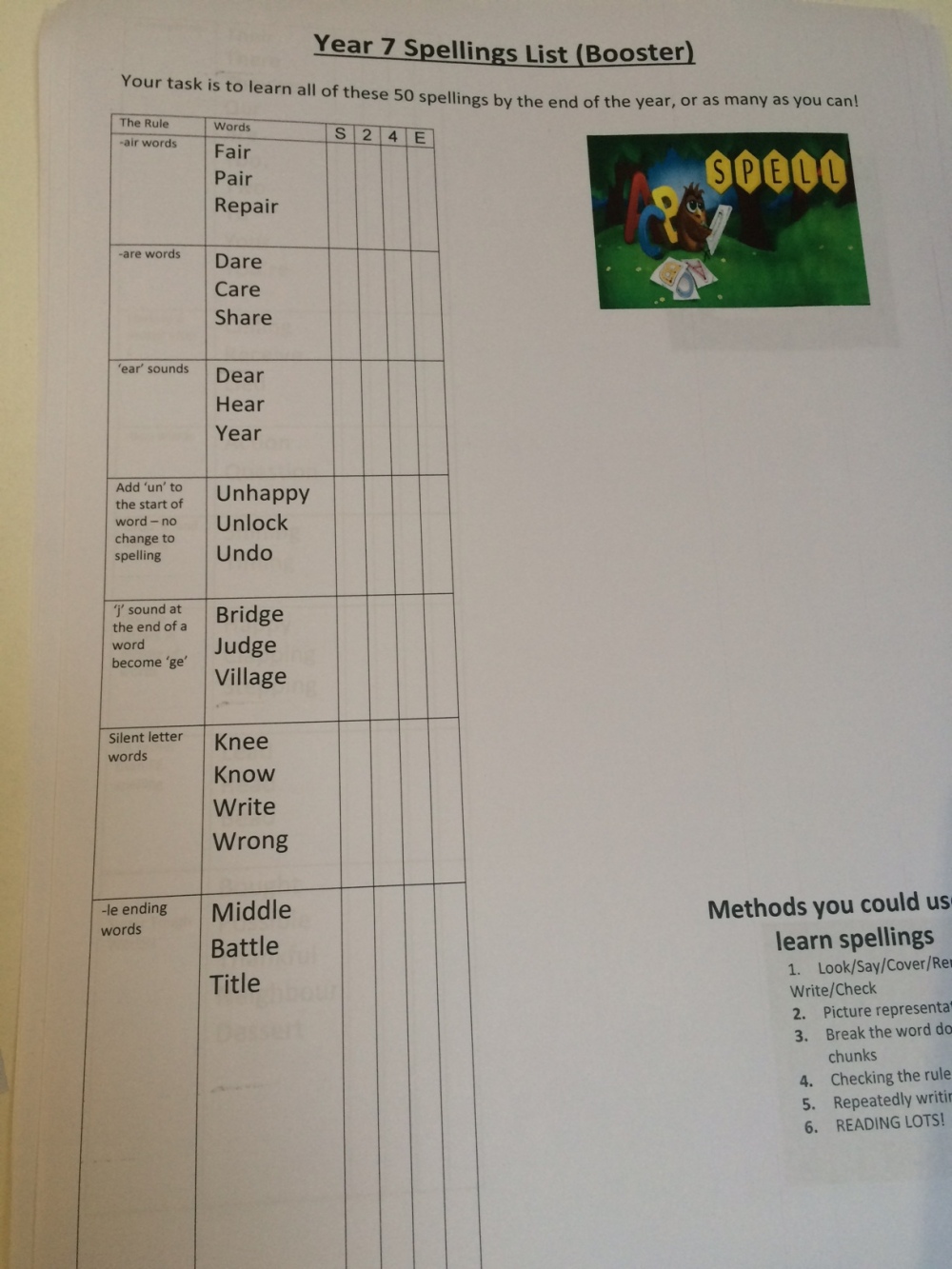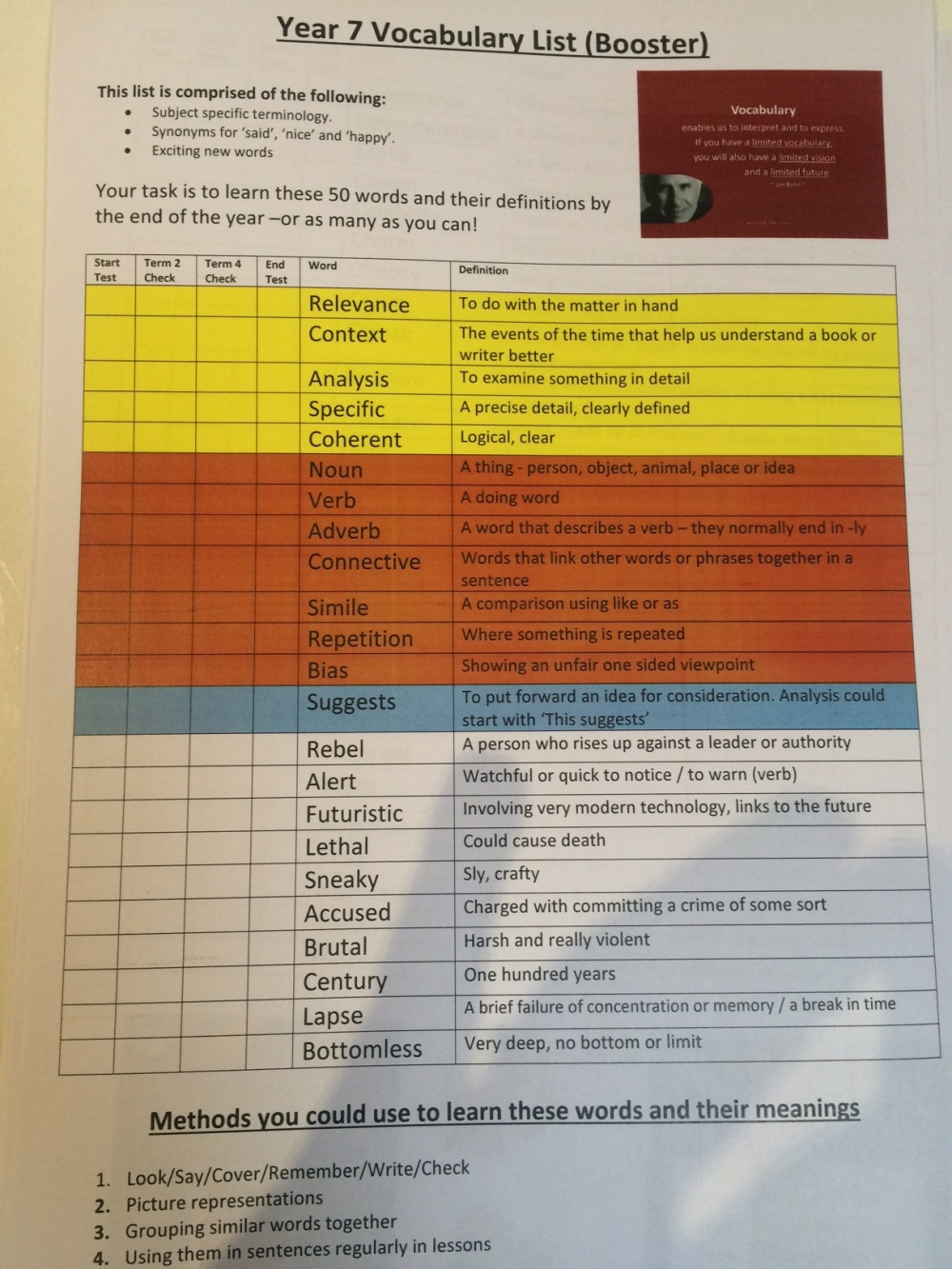Ok, this is basically a post with some spelling and vocabulary lists that I’m sharing. Scroll to the bottom for them. My logic is explained in a few paragraphs/pics first though if you’re interested!

I visited a local primary school a couple of months ago with a view to identifying what they do at KS2 that we could link in to, and bridge the gap. Lots of things impressed, but one thing I particularly liked were Spelling lists. They were used as daily starters and students took time to write out words from a list, four or five times to help them remember. We don’t do enough spelling practice in KS3 currently in my opinion, and there appears to be a deteriorating picture when it comes to spelling competence in Secondary schools. So the simple idea of a list was pretty addictive and useful for learning I thought, but how could I develop this idea and make it potentially better/ particularly useful for us in Year 7 and 8?
I wanted to utilise the vital element of repetitive practice over time and its effect on retention, but in a creative form.
The plan next year is for students to spend 15 minutes in alternate Writing lessons learning the 100 Spellings or 100 Vocabulary choices we’ve set them (50 for lower ability students). We are interleaving reading and writing, so at least once a week a writing lesson will take place, and the starter will be where we focus on spelling or vocab. Homework in Yr 7 and 8 will as well as reading, expect students to slowly build up their knowledge of the sets of 100 words.
I took the following steps to sharpen the process:
Spelling
- Made two lists of 100 words to spell that are accessible and challenging for the vast majority of students for Yr 7 and 8. This was hard! Many lists on the internet don’t quite work. I had to choose a list suitable (I think) for our students.


I also did the following:
- Linked in to important Literacy across the curriculum initiatives like the importance of homophones. Their/There/They’re / Too/To/Two.
- Ensured the great rules that are used in the forming of patterns in students’ minds at KS1&2 (often forgotten about in KS3/4) are referenced.
- Provided challenge particularly on page 2 with my use of commonly misspelt words, then ‘super tough’ ones!
- Importantly, we will put the sheet on the left side of an A3, offering a blank space on the right hand side for students to learn these words creatively, any way they want: pictures / repetition / grouping together / etc. I want the A3 sheets to be illustrated and doodled on!

We also made alternative booster lists of 50 words for weaker students using easier KS1 and 2 spelling rules which are likely still not to have been grasped at age 11/12.
Here’s page 1 of the booster list:

Vocabulary
I was pleased that the Spelling list would develop vocab to an extent, but wanted Vocabulary lists to be a separate learning opportunity. Much has been written about the power of vocabulary development in lots of blogs, not least – Jo Facer and her excellent blog post. I don’t need to sell the importance again here, suffice to say students will be actively encouraged to use words they learn in their extended writing, and I think there will be major benefits to their overall development as English students as their vocabulary grows.

Other things I did:
- Used terms that are in our GCSE criteria (Yellow) (and added some new stuff in Yr 8 version) to establish these early on.
- Used key terminology from our KS4 list (Orange) (and added some new stuff in Yr 8 version) to establish these early on.
- Offered alternatives to ‘This shows’ (my pet hate) (Blue)
- Put in synonyms for said / nice / happy
- Added in some generally exciting new words, but ones that, importantly for me, are useable and not too removed from a student’s vocabulary who reads now and again!
Here’s page 1:

Here’s page 1 of the booster version for students who need it:

Measurability
I’ve set up a way of measuring and quantifying progress during the year as part of the charts. We intend to test how many words students can spell / know during at the start and end of the year, with smaller scale checks at the end of Term 2 and 4. The quantifiable aspect of this is exciting!
ICT dimension
To help learn and retain words, our student surveys show Apps like Memrise are widely used. I particularly like the way students can add in their own tips/images to help them remember words/spellings via this app, and it can also lead to a great competitive element amongst students too as the points rack up. Here are our links below:
Note: you have to sign up / login first to memrise for the links to work.
Year 7 Vocabulary Booster List
I’m excited to see how it goes, and would, as always, welcome feedback!
Here is the full document. It took hours, so I hope it is of use to more than just our department!
Reblogged this on alwayslearningweb.
LikeLike